Top 10 Best GoDaddy Alternatives: Better WordPress Hosting, Domains & Email at a Similar Price?
- By
- Last updated:
- 1 Comment
Searching for the best GoDaddy alternatives for hosting (including WordPress hosting), domains or email?
While GoDaddy is definitely a popular web services provider, it has high prices in some areas (most notably domain registration), poor support and performance, and a lack of some common features, such as free SSL certificates on its cheap hosting plans.
Put those issues together and it’s natural to want to consider your options — and that’s what this post is here for.
Below, I’ve collected the ten best GoDaddy alternatives for web hosting, domain registration and/or email hosting. Most of these providers are cheaper than GoDaddy, while also offering better features and services.
↪️ Note: for anyone looking specifically for WordPress-optimized hosting, take a look at this other post of ours comparing The Best Managed WordPress Hosting Services.
To make it easier for you to find the right alternative for your needs, I’ve divided the post into three sections based on the type of alternative. You can click the links below to jump straight to what you’re interested in or keep reading for the full details:
- Hosting alternatives — I’ve collected five excellent hosting providers that offer better products than GoDaddy, often at a lower price.
- Domain alternatives — I’ve collected three better domain registrars. All of these providers have much cheaper prices than GoDaddy for domain registration, while still offering excellent and reliable services.
- Email alternatives — most of the hosts in the hosting alternatives section include free email hosting, but, if you need standalone email hosting, I’ve collected two great GoDaddy email alternatives.
Table of Contents
- Summary of Top Alternatives for GoDaddy
- Why Is GoDaddy Bad for Hosting?
- Five Best GoDaddy Alternatives for Hosting
- Three Best GoDaddy Alternatives for Domain Registration
- Two Best GoDaddy Alternatives for Email
- Which Is the Best Alternative for You?
Summary of Top Alternatives for GoDaddy
If you’re in a rush, here’s a quick summary of my picks for the best GoDaddy alternatives for hosting, domains and email.
| Service | Alternative For… | Key Differentiator(s) vs GoDaddy |
|---|---|---|
| SiteGround | Web hosting | Better performance, features and support |
| GreenGeeks | Web hosting | Better performance, features and support |
| DreamHost | Web hosting | Much cheaper |
| Bluehost | Web hosting | Better features and more beginner-friendly |
| Kinsta | Managed WordPress hosting | Much better performance, features and support |
| Google Domains | Domain registration | Cheaper and all-around better |
| Namecheap | Domain registration | Cheaper and all-around better |
| Cloudflare Registrar | Domain registration | Cheapest domain registrar in existence |
| MXroute | Email hosting | Cheaper for unlimited email accounts |
| Google Workspace | Email hosting | Simple and reliable for one email account |
Why Is GoDaddy Bad for Hosting?
By the numbers, GoDaddy is the most popular web hosting provider in the world. While it’s hard to know its exact market share, BuiltWith puts it at ~13% and Datanyze has it at ~17%. Long story short: A lot of people use GoDaddy.
But there are tons of reasons why a host may be popular (for example, Super Bowl commercials), and popularity alone doesn’t mean quality.
If you look up GoDaddy reviews on Reddit or Google, you’ll see some troubling similarities between a lot of the negative reviews (of which there are a good number):
- Poor support — in CodeinWP’s 2018 hosting survey of more than 800 WordPress users, GoDaddy’s support scored just 3.3 out of 5, which is a lot lower than some similarly priced hosts. Many users in reviews also complain about poor support.
- Lackluster performance — many GoDaddy users complain about slow page load times or issues with uptime. Page load times are essential, so this is a reason to switch all by itself.
- Lack of features — GoDaddy’s plans lack some features that are common on other similarly priced providers. For example, GoDaddy doesn’t offer a free SSL certificate on its entry-level plans, whereas all of the alternatives on this list do.
To make matters worse, GoDaddy also recently had a huge security vulnerability in its managed WordPress hosting plans that could potentially expose millions of WordPress sites to malicious actions.
If you’ve never experienced issues with any of those things, you may not need to switch. But, if you do have complaints in those areas (or anywhere else), you can find better web hosts for a similar price.
That last qualifier is important — in creating this list of alternatives, I’ve tried to look for hosts that can improve on those weak points at a similar price point.
Can You Migrate Your Website From GoDaddy to Another Host?
As long as you built your website with WordPress, it’s very easy to migrate your site to all of the other hosts on this list. In fact, most of these GoDaddy hosting alternatives will migrate your site for free.
Five Best GoDaddy Alternatives for Hosting
The best GoDaddy hosting alternatives for your situation are going to depend on what GoDaddy plan you’re currently looking at.
The two most popular plans for WordPress users are probably GoDaddy’s shared plans and managed WordPress plans:
- Generic shared plans — start at $5.99 a month ($8.99 upon renewal) for basic shared hosting with cPanel access. You can use it for WordPress or other content management systems.
- WordPress hosting plans — shared WordPress hosting plans start at $6.99 a month ($9.99 upon renewal). These plans offer a custom hosting dashboard with managed features, such as automatic backups, staging sites, automatic updates, and so on. GoDaddy also offers Pro managed WordPress plans starting at $24.99 a month.
If you’re looking at GoDaddy’s Pro managed WordPress plans, you’ll probably want an alternative that also offers those managed features. In that case, consider Kinsta, the fifth option on this list.
On the other hand, if you’re just looking at the shared plans, you’ll probably be happy with any of the first four hosts.
Ready to go? Let’s check out the hosting alternatives…
1. SiteGround
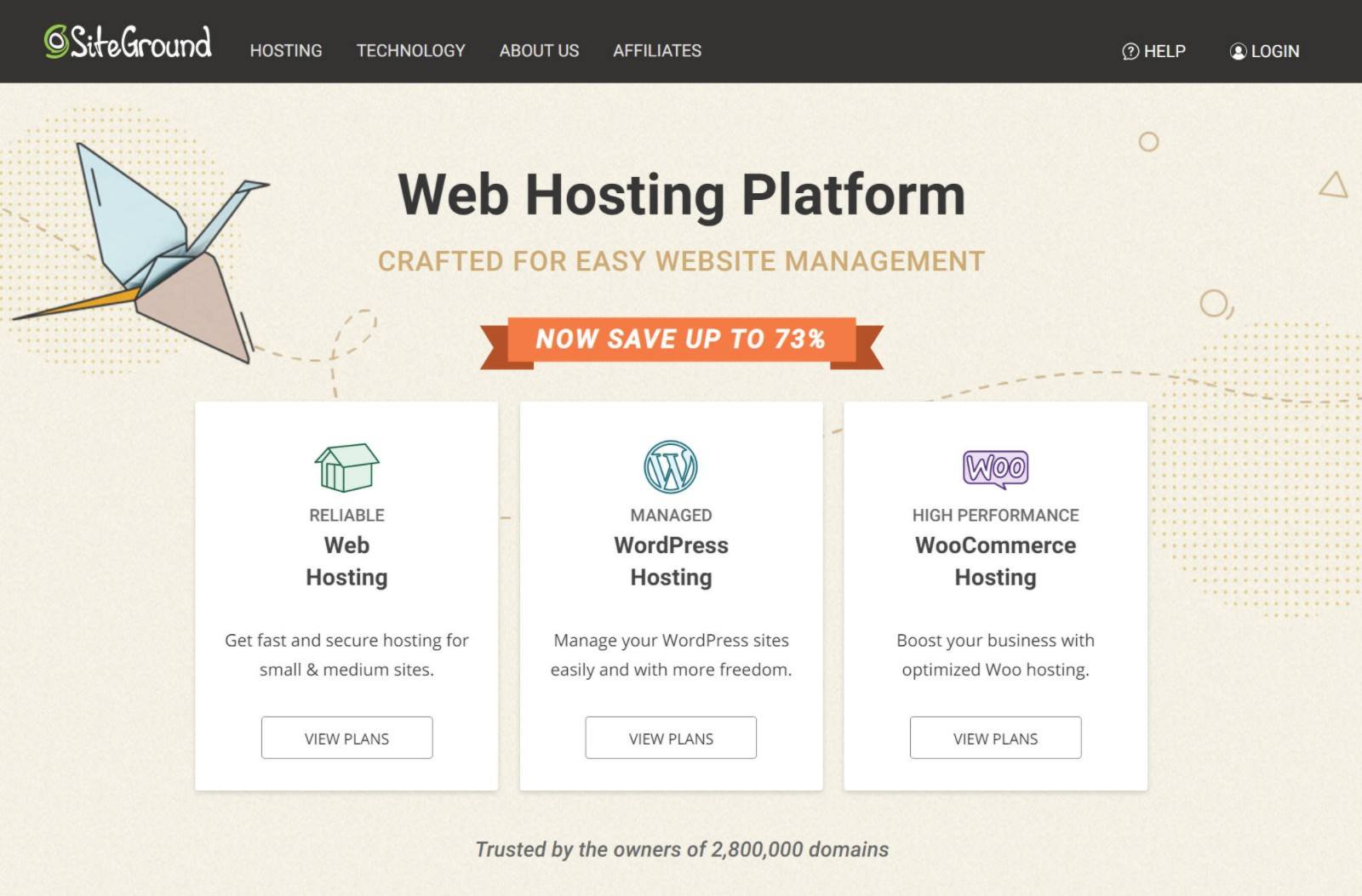
Whereas GoDaddy offers separate shared and managed WordPress plans, SiteGround just offer a single shared hosting plan that includes managed WordPress features.
This makes it a great alternative for both GoDaddy’s shared and managed WordPress plans.
SiteGround has put a lot of work into continually improving its hosting product, recently launching a custom hosting dashboard and moving to Google Cloud infrastructure for all of its hosting plans.
It also offers managed WordPress features such as:
- automatic updates
- staging sites
- server-level caching
- a firewall to protect against security threats.
For the price, SiteGround offers excellent performance. As I mentioned, it now uses Google Cloud infrastructure, and adds top performance optimizations, such as server-level caching and a companion SG Optimizer plugin that helps you to implement a number of WordPress performance best practices.
You can also get support via live chat, ticket and phone. I’ve personally used SiteGround for years and always found the support to not only offer quick response times, but also to actually solve any problems I’ve had. I’ve always used live chat — I’ve never tried the phone support, so I can’t speak for that channel.
SiteGround offers three pricing tiers — you can see the details below:
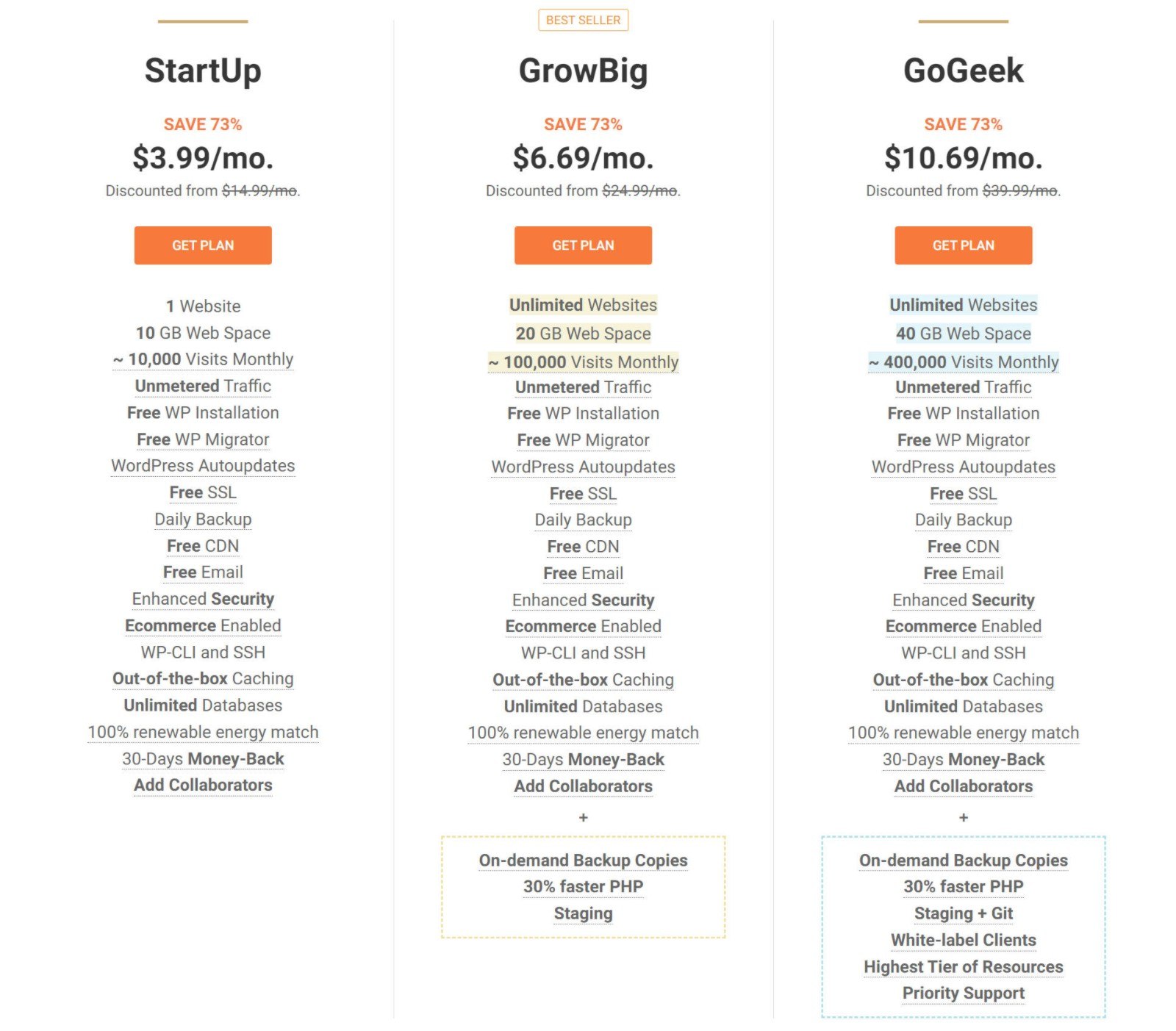
Pros of SiteGround vs GoDaddy
In terms of performance, features and user experience, SiteGround surpasses GoDaddy in all categories:
- Better performance — all things being equal, your site will usually load faster on SiteGround than it will on GoDaddy. A big part of this is SiteGround’s architecture, such as its Google Cloud infrastructure and Nginx Fast_CGI server-level page caching.
- Superior support — SiteGround scored a 4.7 for support in the CodeinWP survey that I mentioned before, which is much higher than GoDaddy’s 3.3 score. It’s actually even higher than some premium managed WordPress hosts, such as WP Engine.
- Custom hosting dashboard — SiteGround has built its own custom hosting dashboard that’s really pleasant to use, whereas GoDaddy only gives you cPanel on its shared plans, and the dashboard for its managed WordPress plans isn’t as nice as SiteGround’s dashboard.
- More features — for example, you’ll get free SSL certificates, staging, automatic WordPress updates, and so on.
Basically, excluding price, SiteGround just plain offers a superior hosting product. However, price may be important to you, which brings me to my next point…
Cons of SiteGround vs GoDaddy
The big disadvantage of SiteGround is its regular non-promo prices are more expensive than GoDaddy’s regular prices.
When you first sign up for SiteGround, you get an attractive promo price, but, after your first billing cycle (which can be anywhere from one to three years), your monthly price will roughly triple.
For example, GoDaddy’s cheapest unlimited shared plan starts at $7.99 a month, whereas SiteGround’s cheapest unlimited shared plan starts at $6.69 a month.
So, SiteGround is cheaper, right? Well, yes — until you have to renew.
Once you go to renew, the full price for the GoDaddy plan is $11.99 a month, while it’s $24.99 a month for SiteGround.
Basically, if you choose SiteGround, you need to pay attention to its renewal prices and try to lock in the promotional prices for the full three years if you can afford the upfront cost.
2. GreenGeeks

GreenGeeks is another excellent budget web hosting provider that offers excellent performance at a price that’s similar to or lower than GoDaddy hosting.
One of the most unique things about GreenGeeks is it offers LiteSpeed Web Server on all of its plans. If you’re not familiar with LiteSpeed, the basic takeaway is GreenGeeks is able to offer excellent website performance even though its prices are very competitive vs GoDaddy.
Another unique detail is that, true to its name, GreenGeeks puts a focus on green energy and renewability. All of its plans offer a 3X energy match, and it also plants one tree for every new hosting account.
Beyond that, GreenGeeks just generally offers a stellar feature list that compares favorably to what GoDaddy offers:
- cPanel hosting dashboard.
- Unlimited websites, storage and bandwidth (excluding the cheapest plan).
- Free email hosting.
- Free SSL certificates.
- Easy WordPress installer.
- Built-in caching for WordPress sites — you can use LiteSpeed’s server-level caching and integrate with WordPress via the bundled LiteSpeed Cache plugin.
- Free automatic backups (with on-demand backups on higher-tier plans).
- WordPress staging sites.
Here are GreenGeeks’ pricing plans:
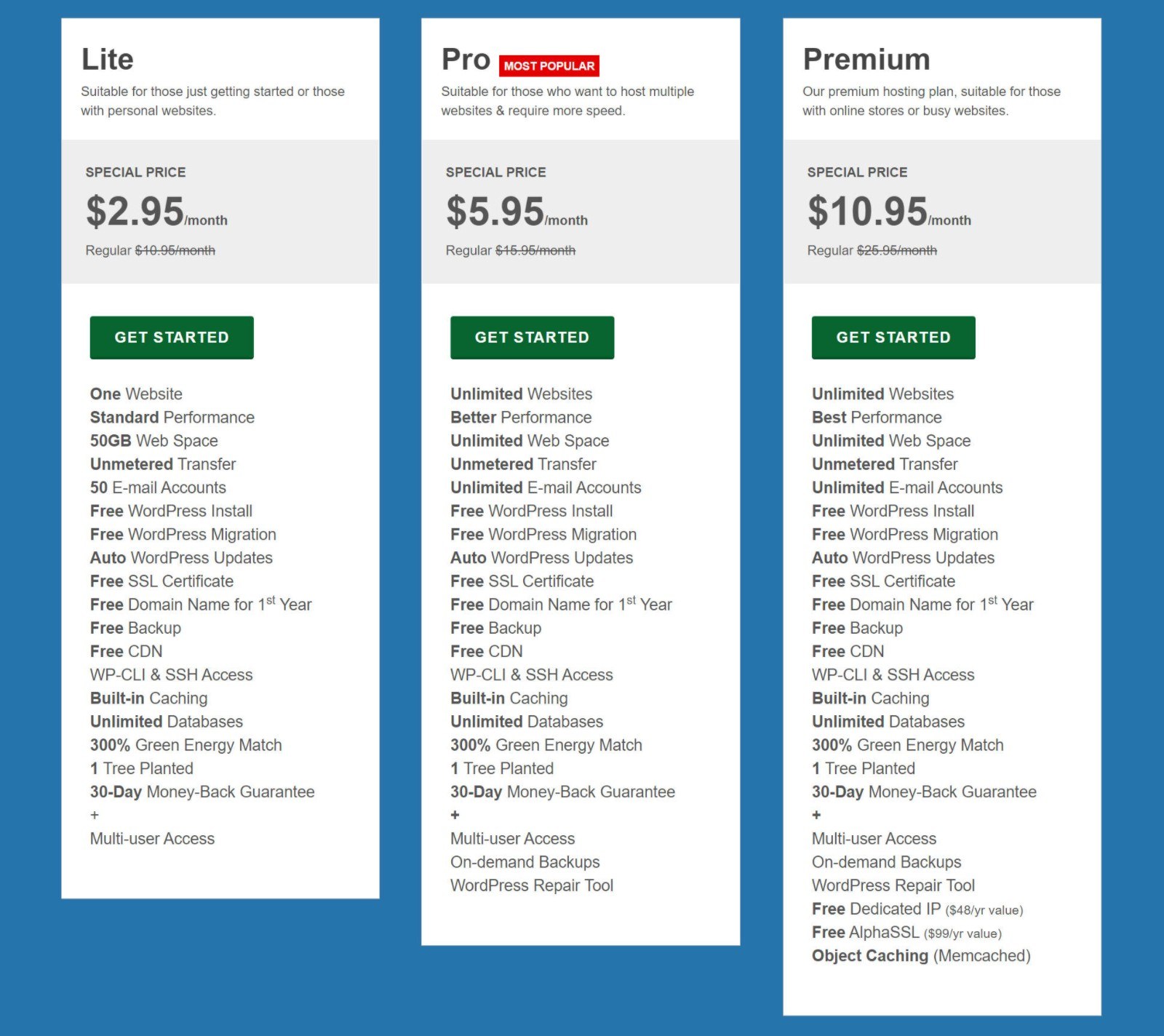
Pros of GreenGeeks vs GoDaddy
GreenGeeks has the same advantages as SiteGround when you compare it to GoDaddy, with the exception of the custom hosting dashboard (because GreenGeeks offers cPanel). That is, you’ll get the following:
- Better performance — GreenGeeks uses LiteSpeed on all plans, which offers excellent performance.
- Superior support — GreenGeeks provides solid support for a budget host.
- More features — you’ll get features such as free SSL certificates, staging sites, and so on.
Cons of GreenGeeks vs GoDaddy
GreenGeeks doesn’t really have many disadvantages vs GoDaddy’s shared hosting. The only thing worth noting is that GreenGeeks is a little more expensive than GoDaddy when you factor in renewal prices, though not by much.
Like SiteGround, GreenGeeks offers very cheap promotional prices for your first billing term. But, once you exceed that, GreenGeeks is ~25% more expensive than GoDaddy’s cheap hosting.
3. DreamHost

DreamHost is a well-established web host that’s been around since 1996.
If you’re looking for an alternative to GoDaddy’s shared hosting, DreamHost offers generic or WordPress shared plans starting at just $2.59 a month. It also has an affordable managed WordPress offering called DreamPress that makes a good alternative to GoDaddy’s managed WordPress hosting.
No matter which plan you go with, you’ll get access to a number of helpful features, such as:
- Custom hosting dashboard — DreamHost built its own custom hosting dashboard, which you may prefer to GoDaddy’s cPanel approach.
- Free SSL certificates on all plans — these are powered by Let’s Encrypt.
- Automatic daily backups — DreamHost backs up your site every day — even on its cheap shared plans.
- Automatic WordPress updates — DreamHost automatically updates your core WordPress software — even on its cheap shared plans.
DreamPress, the managed WordPress hosting plan, also offers one-click staging sites, a bundled Jetpack Professional license, server-level caching and a more robust backup solution.
DreamHost’s shared hosting plans start at just $2.59 a month with a three-year commitment or $4.95 a month with month-to-month billing:
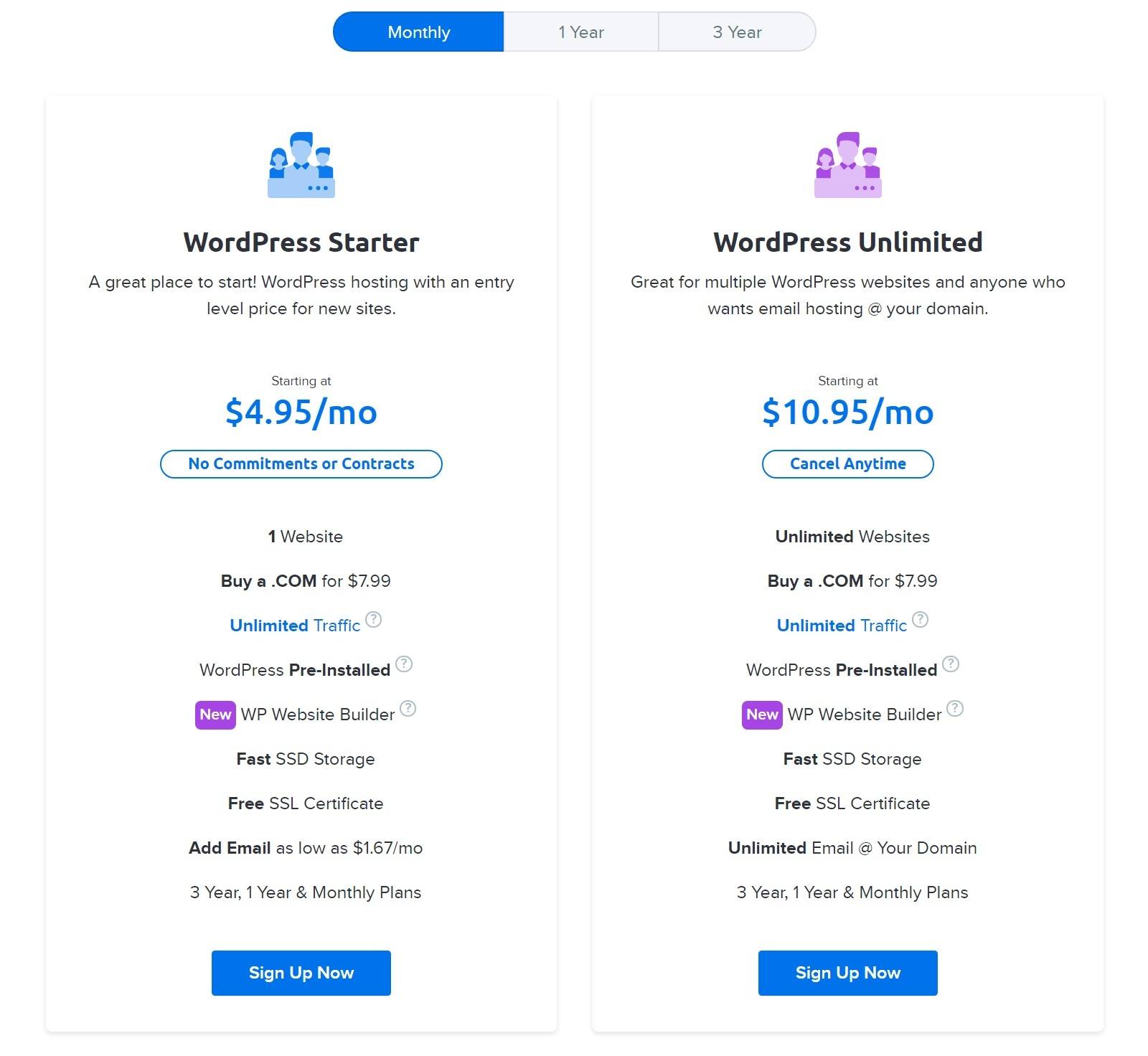
The DreamPress plans start at $16.95 a month with annual billing or $19.95 a month with month-to-month billing:
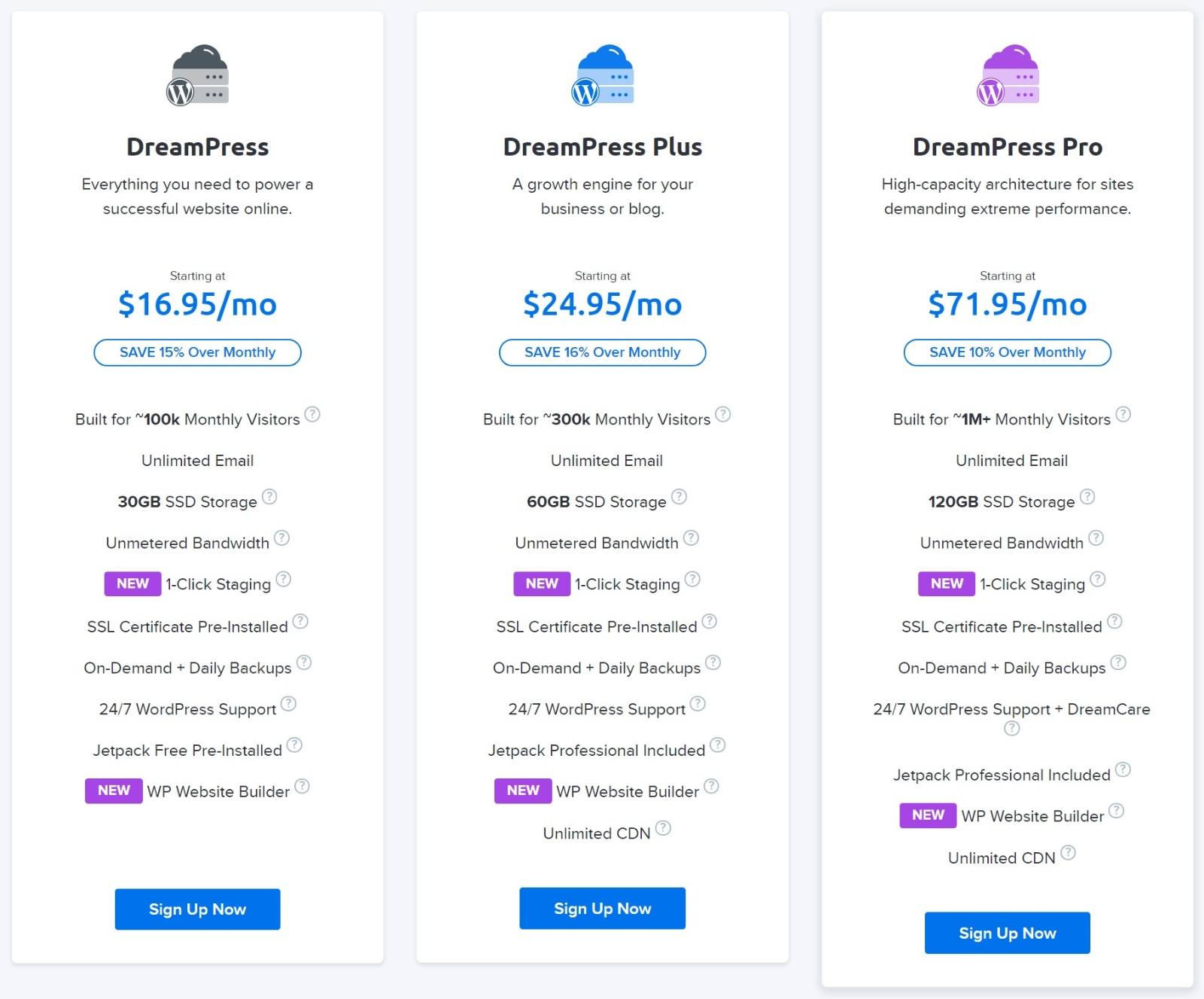
Pros of DreamHost vs GoDaddy
One big advantage of DreamHost over GoDaddy (and the other alternatives on this list) is the pricing. Not only are the prices affordable and transparent with DreamHost, but it’s also one of the few hosts to offer month-to-month billing on cheap shared plans.
With GoDaddy, the minimum commitment is three months, which has an inflated price vs the yearly plans. On the other hand, DreamHost lets you pay month-to-month while still keeping the price low.
DreamHost’s managed WordPress hosting is also cheaper than GoDaddy’s Pro managed WordPress hosting.
Beyond offering more accessible pricing, DreamHost also offers more features than GoDaddy. For example, DreamHost’s cheapest hosting plan still comes with a free SSL certificate, the custom hosting dashboard and automatic backups.
GoDaddy does offer an automatic backup service on its shared plans, but it’s an extra $2.99 a month.
Finally, DreamHost’s support performed a lot better according to the CodeinWP survey. DreamHost’s support scored a 4.0, which is well above GoDaddy’s 3.3.
Cons of DreamHost vs GoDaddy
In terms of support quality, DreamHost beats GoDaddy. But DreamHost doesn’t beat GoDaddy when it comes to availability. DreamHost offers 24/7 ticket support, but live chat support is only available from 5.30am to 9.30pm PT.
In contrast, GoDaddy’s support channels are all open 24/7, which is something to consider if you prefer live chat support and live somewhere where DreamHost’s hours aren’t convenient for you.
4. Bluehost

Though Bluehost isn’t quite as popular as GoDaddy, it’s definitely another one of the world’s most well-known hosting companies.
Like GoDaddy, Bluehost offers both cheap shared hosting plans and affordable managed WordPress hosting plans.
However, unlike GoDaddy, Bluehost has done an excellent job of building a great user experience — even on its cheap shared plans. While Bluehost does still give you cPanel access like GoDaddy, it’s also built its own custom hosting dashboard on top, which makes it a lot easier to work with your website.
Bluehost has also added helpful features, such as staging and free SSL certificates, to even its cheapest shared hosting plans, which is another thing GoDaddy doesn’t offer.
If you’re looking for cheap shared hosting, Bluehost’s regular prices are quite similar to GoDaddy’s, though Bluehost offers larger promotional discounts for your first billing cycle:
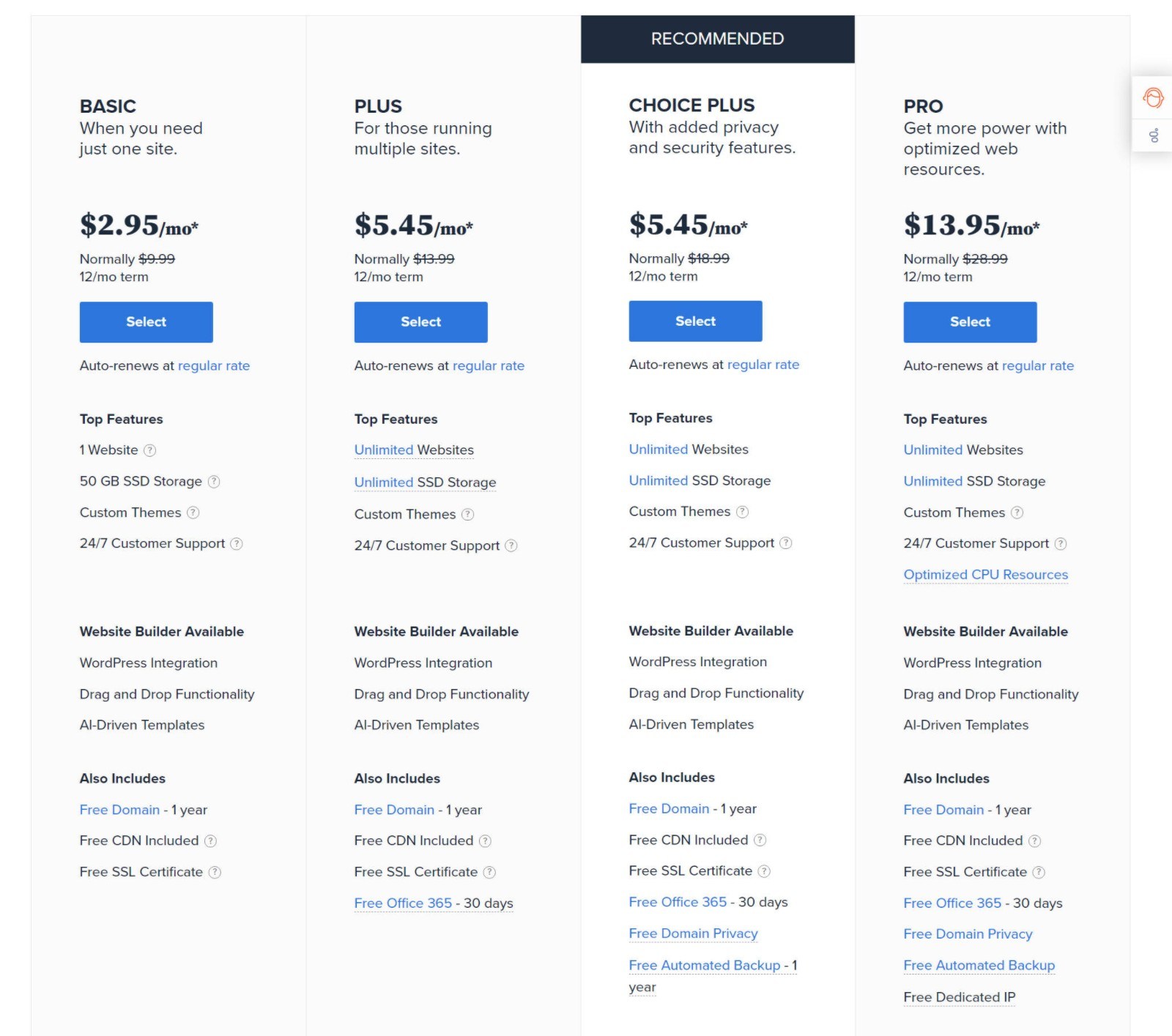
If you’re looking for an alternative to GoDaddy’s managed WordPress hosting, you may prefer Bluehost’s WP Pro managed WordPress plans, which are priced similarly to GoDaddy’s Pro managed WordPress hosting plans and offer premium value-adds, such as integrated Jetpack Premium:
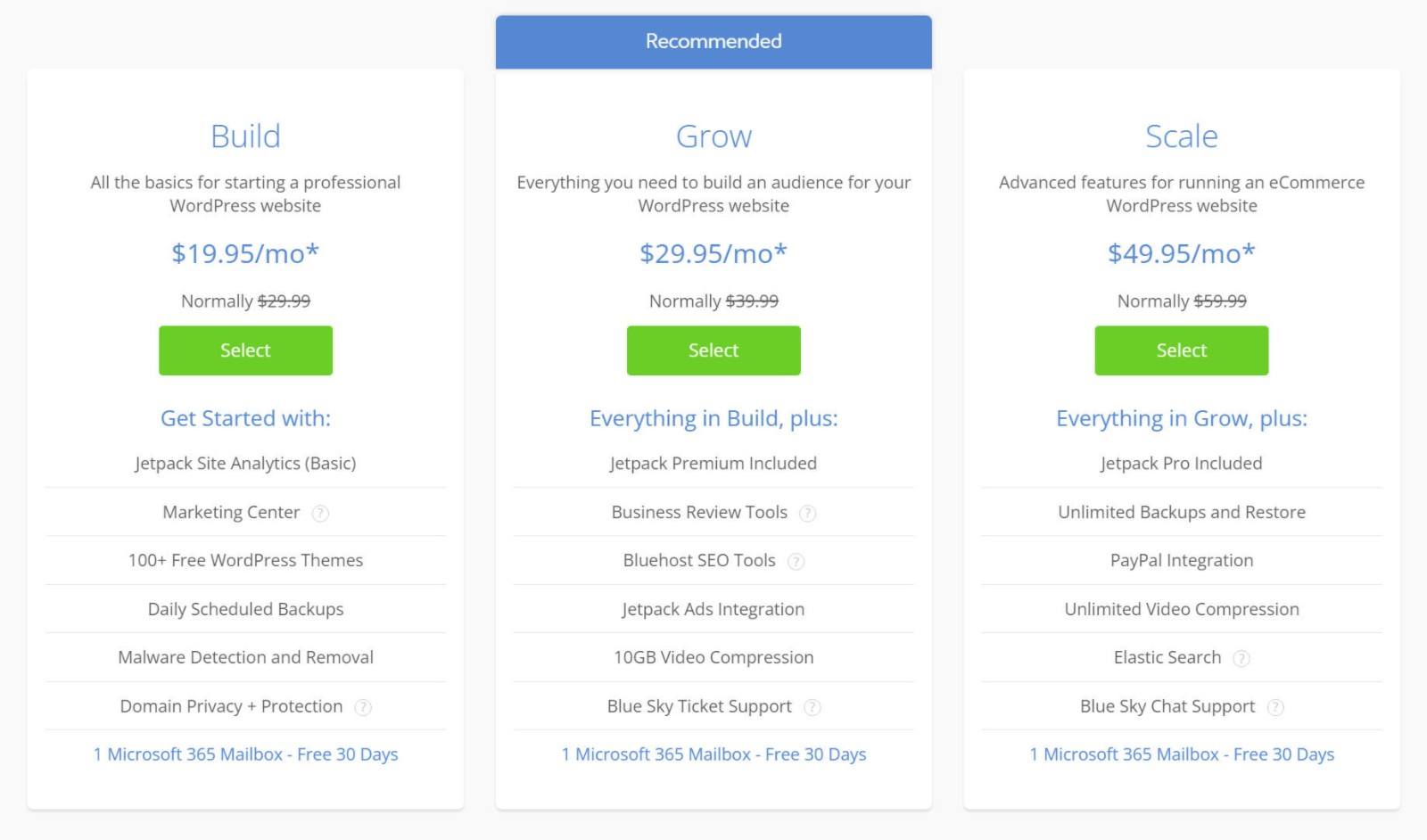
Pros of Bluehost vs GoDaddy
The big advantages of Bluehost vs GoDaddy are the user experience and features.
First, you get the custom hosting dashboard on top of cPanel, which makes it more pleasant to manage your sites on Bluehost.
Second, Bluehost just plain offers more features than GoDaddy, especially when you look at GoDaddy’s cheap shared plans.
For example, even on Bluehost’s cheapest shared WordPress hosting plans, you’ll still get features such as:
- automatic WordPress updates
- free SSL certificates (GoDaddy only offers this on its higher-tier plans)
- WordPress staging sites (via the Bluehost plugin — it doesn’t work for non-WordPress sites).
Basically, Bluehost offers a more user-friendly, feature-rich hosting experience at a similar price point.
Cons of Bluehost vs GoDaddy
Just as people complain about GoDaddy’s performance and support, you’ll also find many of those same complaints about Bluehost’s offerings.
For example, while GoDaddy’s support received a 3.3 in that CodeinWP survey, Bluehost’s support actually scored lower at 3.2.
So, if the biggest reason you’re moving from GoDaddy is its support and performance, Bluehost really isn’t going to be any better in those areas. In that case, I’d recommend choosing one of the other hosting providers on this list.
5. Kinsta

Kinsta is a premium managed WordPress host that make a great GoDaddy managed WordPress hosting alternative.
Kinsta is significantly more expensive than the four previous hosts on this list, so it isn’t a great option if you’re on a tight budget. But if you’ve been paying for GoDaddy managed WordPress hosting and you want to make a jump up in pretty much every aspect, Kinsta is a great choice.
As a premium host, Kinsta gives you premium performance and reliability to match. You’ll be impressed by how much faster your site loads, and you also get excellent support and infrastructure reliability.
Beyond that, Kinsta offers a custom hosting dashboard and tons of useful features, including the following:
- Built-in WordPress caching.
- Built-in content delivery network (CDN) for improved global performance.
- 29+ global data centers.
- Automatic daily backups, plus on-demand backups when needed.
- Easy staging sites.
- Proactive security rules, such as firewalls and DDoS protection, plus a free hack fix guarantee.
- Built-in uptime monitoring.
Kinsta’s pricing starts at $30 a month, which isn’t that much more than GoDaddy’s Pro plans:
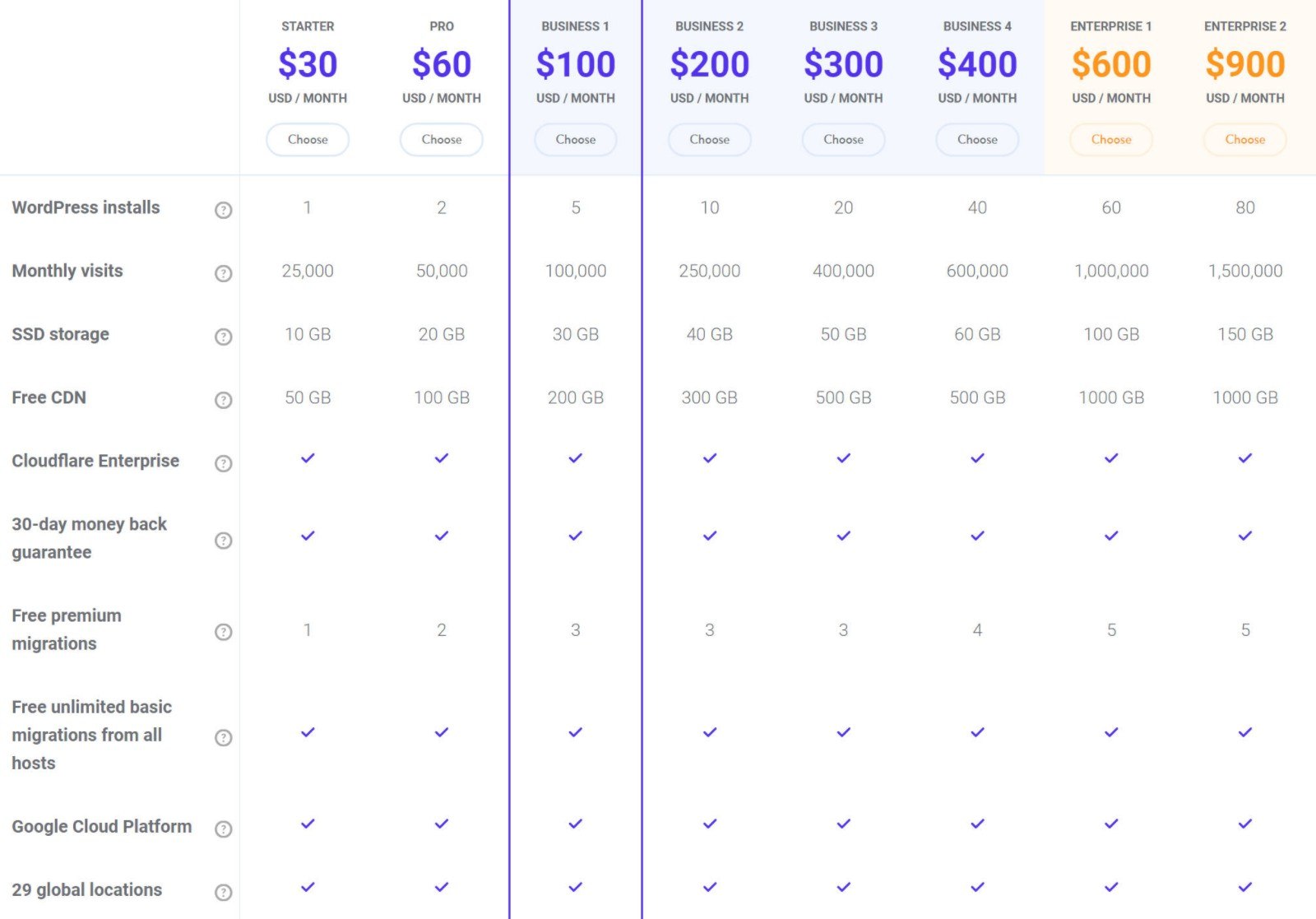
Pros of Kinsta vs GoDaddy
If you take price out of the equation, Kinsta’s hosting is better than GoDaddy’s managed WordPress hosting in every single area:
- Faster performance — your WordPress site will load significantly faster on Kinsta.
- Better features — Kinsta’s dashboard is very user-friendly and packed with useful tools. You also get unique tools such as Kinsta Application Performance Monitoring to find performance bottlenecks and DevKinsta for local WordPress development.
- More reliable — Kinsta’s hosting is more reliable and it does a better job of security. For example, GoDaddy recently had a massive security breach of its managed WordPress hosting, which isn’t something Kinsta has ever had happen.
- Better support — Kinsta offers excellent expert WordPress support that’s available around the clock.
Cons of Kinsta vs GoDaddy
The only con of Kinsta is it’s more expensive than GoDaddy. Beyond that, Kinsta is better than GoDaddy in every way. So, while you’re paying more, you’re also getting much better value for your money.
Note: If you like Kinsta, you also may want to check out WP Engine. WP Engine is also an excellent managed WordPress hosting provider that competes in the same space as Kinsta. If you’re willing to pay $30+ per month to host a single site, it’s also worth a look. Here’s some related reading:
Three Best GoDaddy Alternatives for Domain Registration
I’m going to be a little blunt here: GoDaddy is (in many people’s opinion – including my own) a horrible domain registrar, so it’s pretty easy to find quality GoDaddy alternatives for domains.
Unlike hosting, which has a lot of variability in services and performances, there’s very little to differentiate domain registrars beyond their prices and some basic add-ons, most notably domain privacy.
And here’s the main issue with GoDaddy for domains:
GoDaddy’s prices are insanely high, in large part because it raises the price after the first year once it’s lured you in with the cheap promotional price. For example, GoDaddy charges $18.99 for a .com domain name from the second year on, whereas these alternatives charge ~$8-$14 for the same domain name.
Honestly, I’d personally never recommend that someone use GoDaddy for domains — use one of these alternatives instead for lower prices, better services and just a generally better experience.
6. Google Domains
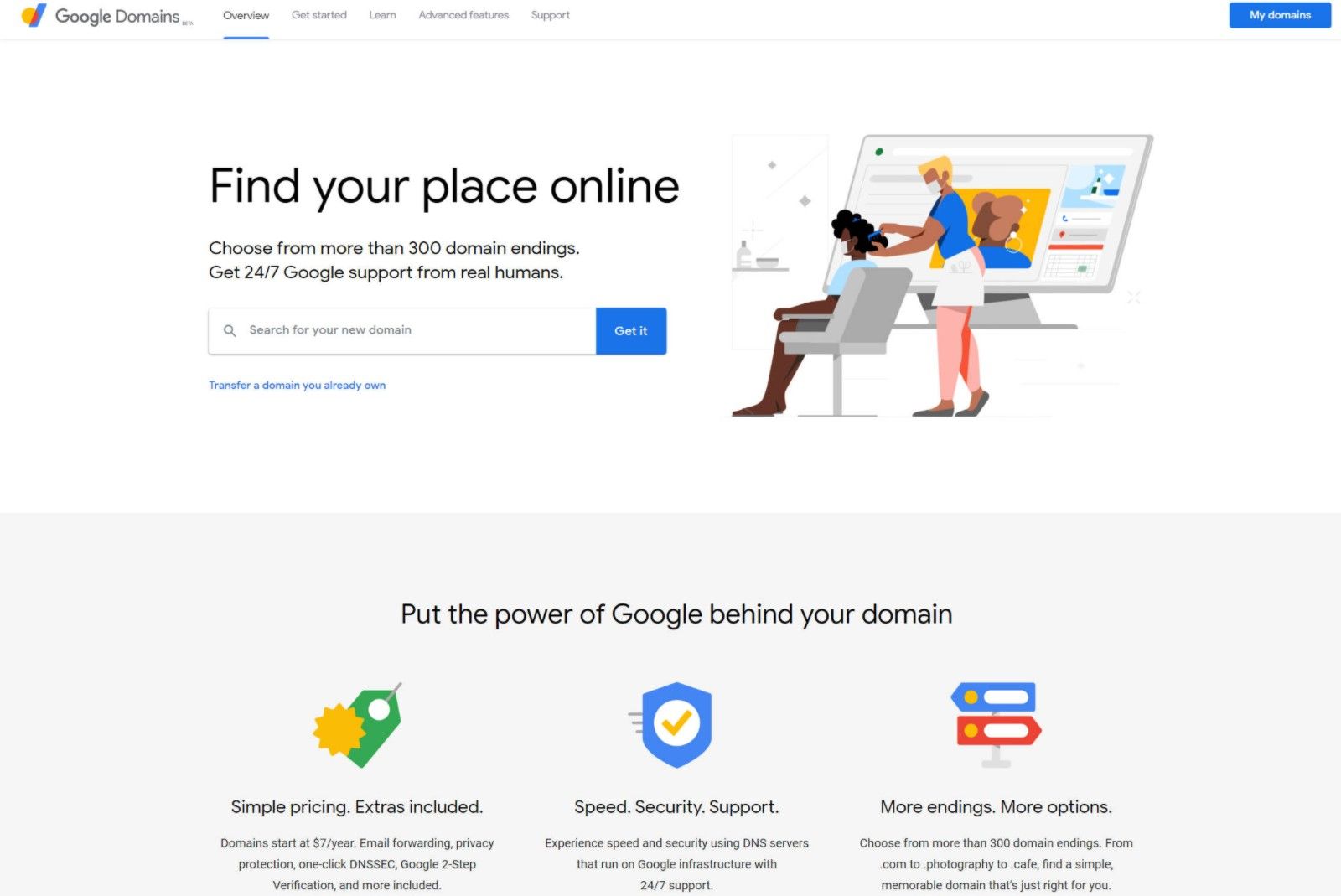
Google Domains is the registrar I’ve started using for all of my new domain purchases.
There are two main reasons why I like Google Domains and why I think it’s significantly better than GoDaddy for domains:
- Price — Google Domains is significantly cheaper. I’ll give you a full comparison table below, but GoDaddy charges 58% more than Google Domains for .com domains.
- Interface — Google Domains has a really nice interface and you can use your existing Google account to manage everything.
Google Domains also offers all of the features you’d expect from a quality domain registrar, including the following:
- Free WHOIS privacy protection.
- Free DNSSEC option.
- Two-factor authentication to protect your account.
- Free DNS hosting.
It also offers one-click integrations for popular providers including Shopify, Squarespace and Wix.
Google Domains vs GoDaddy Prices
To give you an idea of Google Domains vs GoDaddy when it comes to prices, let’s look at the cost for some popular extensions.
Google Domains doesn’t use a promotional pricing strategy like GoDaddy, so the price you’ll pay for the first year is the same as what you’ll pay to renew. There are never any price jumps.
| Extension | Google Domains | GoDaddy |
|---|---|---|
| .com | $12 | $18.99 |
| .net | $12 | $19.99 |
| .org | $12 | $20.99 |
| .io | $60 | $62.99 |
| .info | $12 | $28.99 |
Overall, there’s really no competition — Google Domains is significantly cheaper than GoDaddy for all of the popular domain extensions.
7. Namecheap
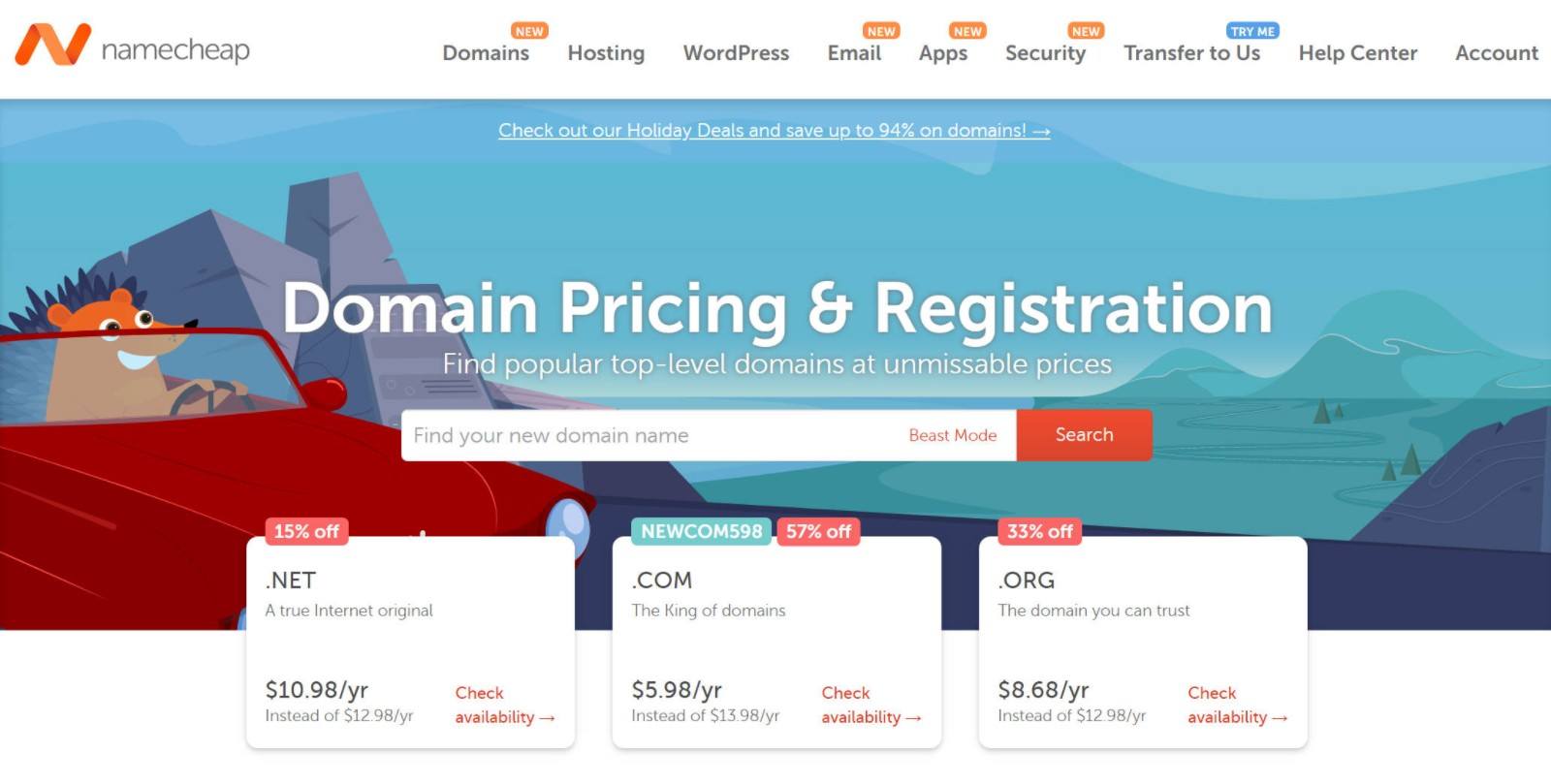
Namecheap is the registrar I previously used before shifting new purchases to Google Domains and I still have a number of domains there. In terms of popularity, it’s one of the most well-known GoDaddy competitors in the domain registration space.
I was, and am, quite happy with Namecheap’s services. I didn’t switch because of a problem, I just switched because I liked Google Domains even more.
Like Google Domains, Namecheap also offers everything you’d want in a domain registrar at lower prices than GoDaddy. Here’s what you get:
- Free domain privacy protection.
- Two-factor authentication.
- Free DNSSEC security.
Namecheap vs GoDaddy Prices
To give you an idea of Namecheap vs GoDaddy costs, let’s compare the prices for some popular extensions. You can also find lots of Namecheap coupons that give you a discount on the first year (much like GoDaddy’s first-year domain discount), but I’m looking at the full prices in this comparison.
| Extension | Namecheap | GoDaddy |
|---|---|---|
| .com | $13.98 | $18.99 |
| .net | $12.98 | $19.99 |
| .org | $12.98 | $20.99 |
| .io | $39.98 | $62.99 |
| .info | $15.98 | $28.99 |
8. Cloudflare Registrar
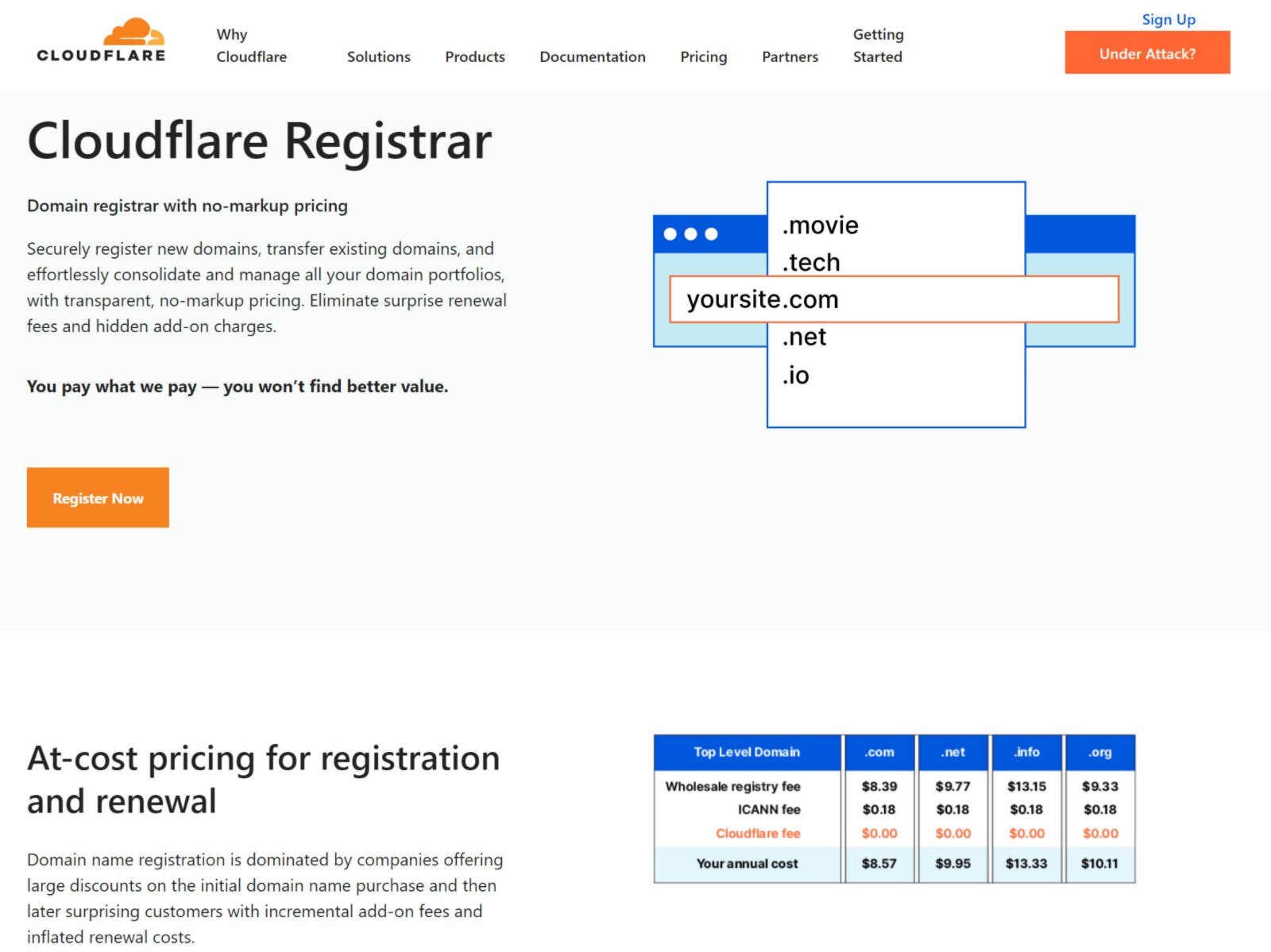
Cloudflare Registrar is the absolute best domain registrar if price is your main motivation. Why? Because Cloudflare Registrar offers domain names with zero markup beyond the unavoidable wholesale/ICANN fees associated with registering the domain name.
Essentially, that means Cloudflare Registrar has no profit. You literally can’t find a cheaper domain registrar than this, because a domain registrar would have to be losing money to offer lower prices.
Because of this, Cloudflare Registrar doesn’t offer tons of features, but the service still has everything most people need.
For example, Cloudflare Registrar doesn’t offer a dedicated WHOIS privacy service like Namecheap or Google Domains, but it does support WHOIS redaction, which lets you hide your data from WHOIS searches in a different way on most domain extensions.
With this setup, your information will show as ‘DATA REDACTED’, instead of showing the privacy service’s information like with Google Domains or Namecheap. Here’s an example of what your information will look like when people search for it:
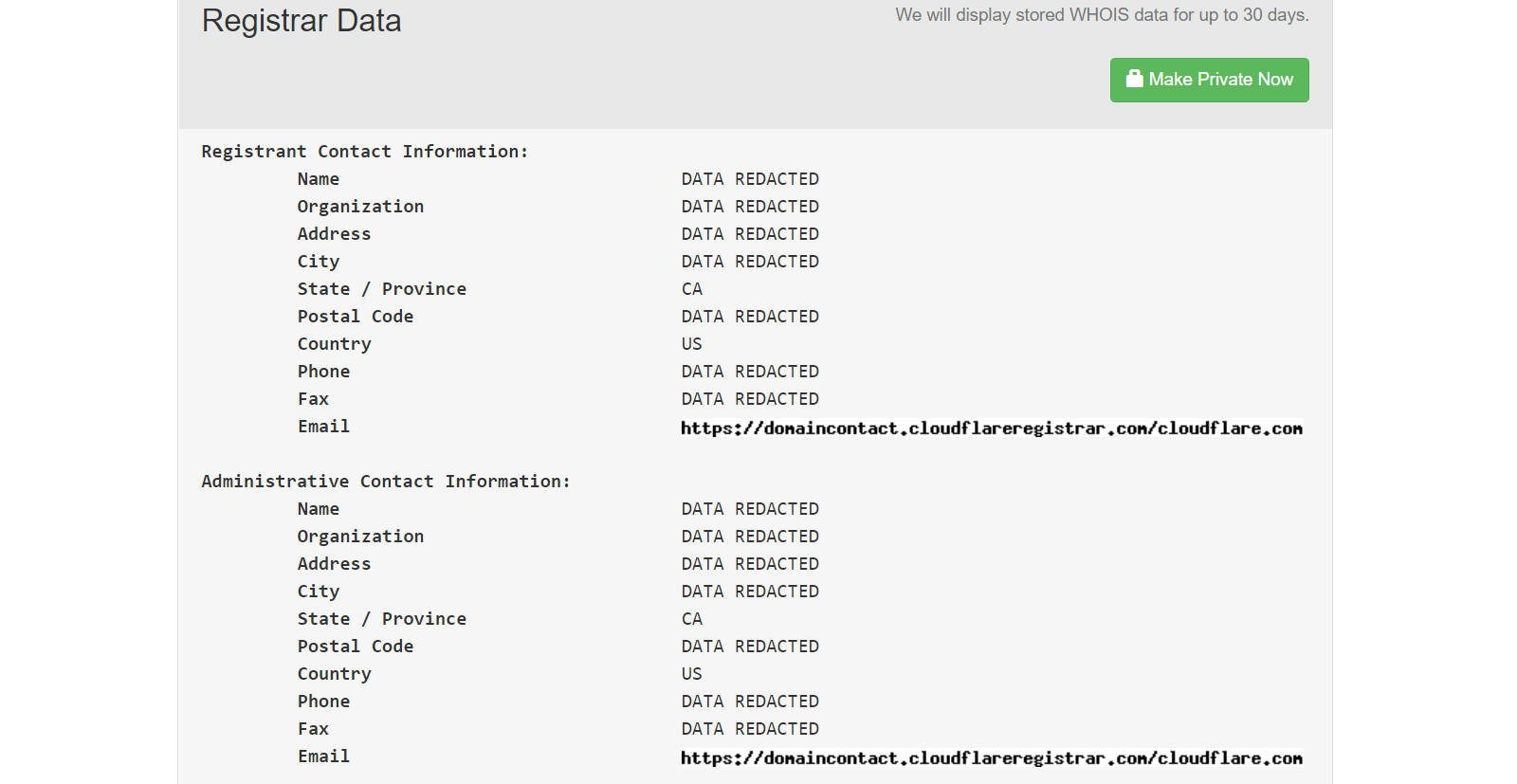
This example is for a .com domain name.
The only notable restriction is you must use Cloudflare’s nameservers if you use Cloudflare Registrar. You can still point your domain name to any hosting provider — you just need to use A records instead of editing the nameservers.
Cloudflare Registrar vs GoDaddy Prices
Cloudflare Registrar is the cheapest domain registrar possible, so you can bet it compares favorably to GoDaddy in the price department.
| Extension | Cloudflare Registrar | GoDaddy |
|---|---|---|
| .com | $8.57 | $18.99 |
| .net | $9.95 | $19.99 |
| .org | $10.11 | $20.99 |
| .io | Not supported | $62.99 |
| .info | $13.33 | $28.99 |
Two Best GoDaddy Alternatives for Email
If you’re searching for GoDaddy email alternatives, it’s first worth pointing out that almost* all of the hosting providers I covered earlier offer free email hosting as part of their services.
So, if you’re in the market for web hosting and email hosting, you may just need one of those services instead of a dedicated GoDaddy email alternative.
However, if you need or prefer standalone email hosting, you can also find some excellent providers that compare favorably with GoDaddy’s email hosting.
*The only exception is Kinsta — Kinsta doesn’t offer email hosting on any plan.
9. MXroute
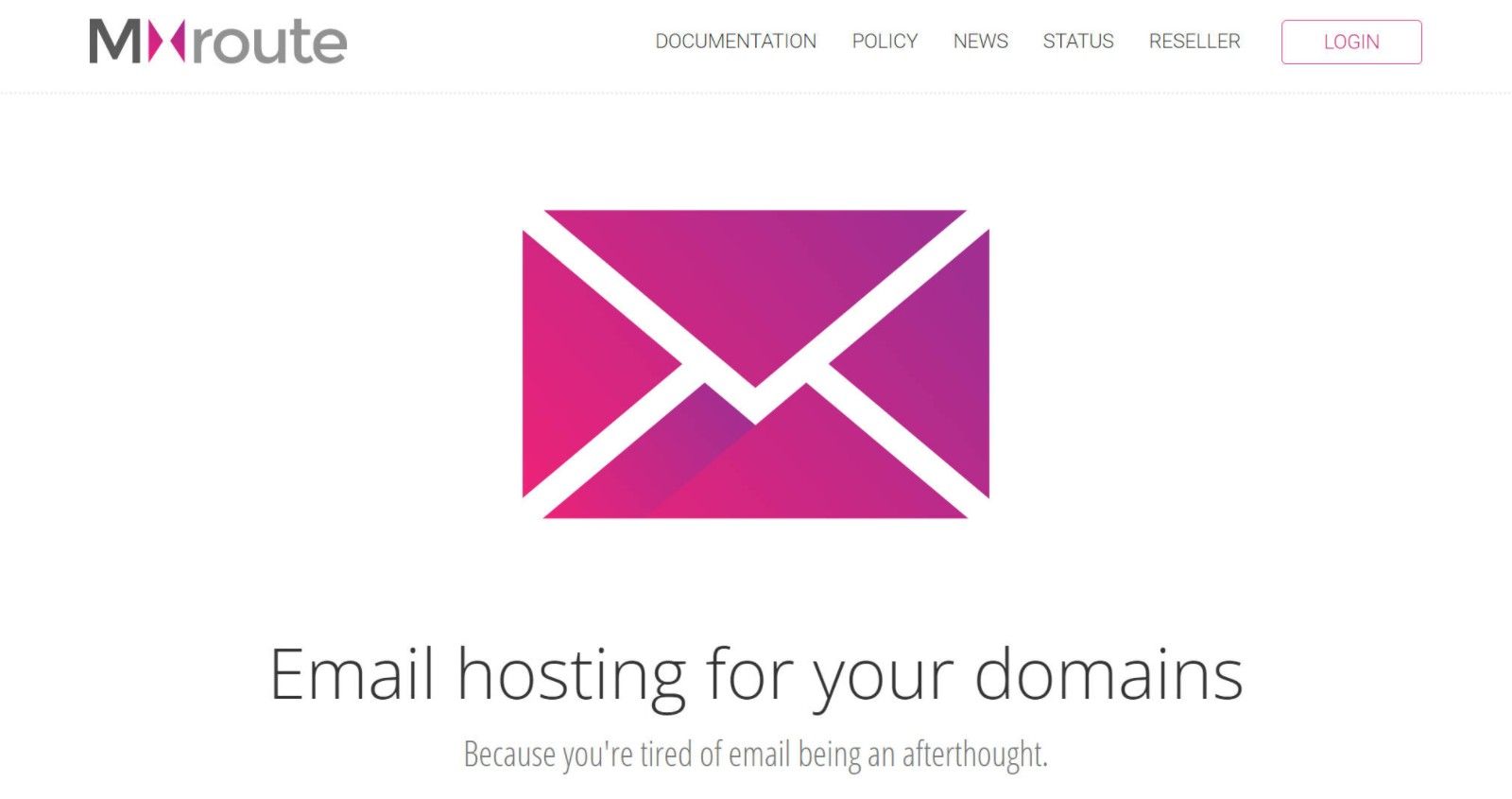
MXroute is a great email hosting provider if you think you’ll need to have lots of separate email accounts.
All of the email hosting plans support unlimited domains and unlimited email accounts. The only limits are on the amount of storage you have.
To manage all of your email accounts, you’ll use a tool called DirectAdmin. It’s not the most user-friendly tool, but it’s totally functional and pretty easy to use once you get a handle on things.
Here are some of the other notable features:
- Webmail — MXroute offers Afterlogic Pro, CrossBox, Rainloop or Roundcube for webmail. Or, you can connect your email accounts to other email clients (even Gmail, with a workaround).
- Spam filtering — MXroute has its own custom spam rules designed to protect your accounts.
- High reputation IP addresses — these help to make sure your emails don’t get flagged by recipients’ spam filters.
Overall, MXroute isn’t the best option for total beginners, but for moderately technical people it offers excellent value if you need a lot of different email accounts.
MXroute offers three pricing plans, pictured below. Note that these prices are per year, so the entry-level plan costs less than $4 a month.
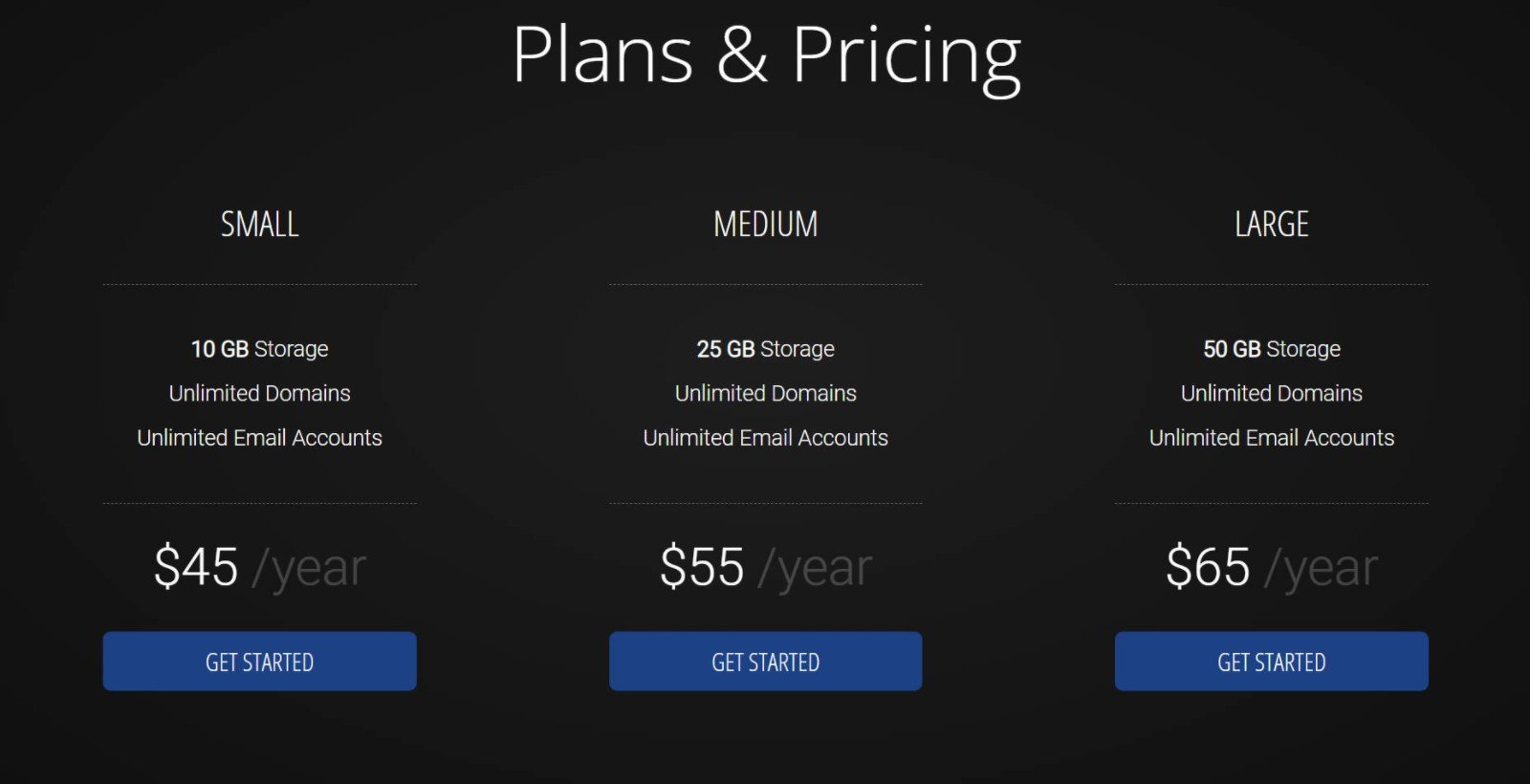
10. Google Workspace

Whereas MXroute is great if you’ll have lots of different accounts, Google Workspace is excellent if you’re just looking for email hosting for your own business email (or maybe a few team members).
It’s more expensive than MXroute, but the upside is it’s rock-solid, simple to use and gives you access to lots of useful tools beyond email. You also get to use a dedicated, ad-free Gmail interface for your email, which is an advantage if you like Gmail.
The setup process is also much simpler than MXroute, which is great if you’re not a very technical person.
The only downside? Google Workspace is a bit more expensive than other email hosting options. This is the price you pay for simplicity and hands-off reliability.
If you’re an individual who just needs a single account, you can use the Google Workspace Individual plan. This has the simplest setup for individual users, but it costs $9.99 a month.
If you want to save some money, or if you have a team, you can use the team-based Google Workspace Business plans (yes, even if you’re the single member of your team).
These plans are cheaper at just $6 per user per month, but the setup process is a little more complicated.
Personally, I use the cheapest Business Starter plan, which lets me manage my personal email account for just $6 a month.
Which Is the Best Alternative for You?
At this point, you should hopefully have a good idea of which GoDaddy alternative is right for you. If not, here are some quick summaries to guide your choice.
Let’s start with hosting:
- SiteGround — excellent features, support and performance. However, its regular prices are higher than GoDaddy’s, so you’ll be paying a slight premium.
- GreenGeeks — similar pros and cons to SiteGround. It’s a little bit cheaper than SiteGround, so it may be better if you’re on a tight budget.
- DreamHost — affordable prices with month-to-month billing. It also offers more features than GoDaddy and has superior support, though live chat isn’t available 24/7.
- Bluehost — you won’t notice a huge improvement with support or performance, but you’ll get access to a more pleasant hosting dashboard and more features than GoDaddy offers.
- Kinsta — a premium managed WordPress host, go with Kinsta if you’re willing to pay for the absolute best performance, features and reliability.
In terms of alternatives for domain registration, here’s the recap:
- Google Domains — a great all-around option that’s cheaper than GoDaddy and lets you use your existing Google account.
- Namecheap — offers first-year coupons that make domain registration very cheap, and the renewal prices are still cheaper than GoDaddy.
- Cloudflare Registrar — the cheapest domain registrar in existence because there’s no markup. It still has everything most people need, especially because you can redact WHOIS information.
Finally, in terms of GoDaddy email alternatives, here are my picks:
- MXroute — the best option if you need lots of different email accounts.
- Google Workspace — the best option if you only need a personal email account.
Related Reading:
- The Best Managed WordPress Hosting Services Compared – With Speed Tests!
- Bluehost vs SiteGround WordPress Hosting Compared – Which Is Best?
- Bluehost, GoDaddy or SiteGround: Which is the Best Web Hosting Service for WordPress?
- Flywheel WordPress Hosting – An In-Depth Everything-You-Need-To-Know Review
- Kinsta Managed WordPress Hosting Tried and Tested – Is It Really All That Good?
- WP Engine WordPress Hosting Review – Does It Really Make a Difference?
Used/using any of these GoDaddy alternatives? Thoughts?
Leave a Reply
All comments are held for moderation. We'll only publish comments that are on topic and adhere to our Commenting Policy.

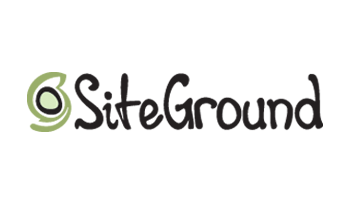

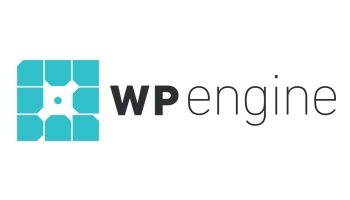
There are various companies like A2 Hosting, DomainRacer & InMotion in the market for web hosting. Everybody claims to be the best provider but are they really helpful throughout our journey? I want directions to choose the best alternative for godaddy from these companies.